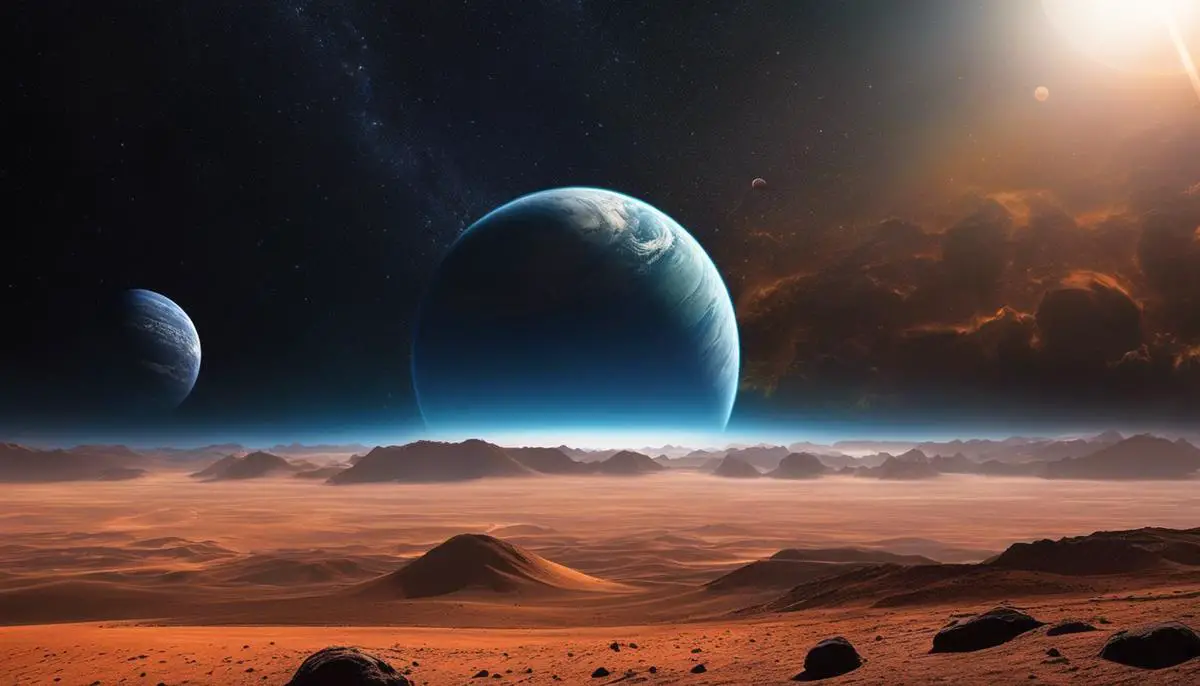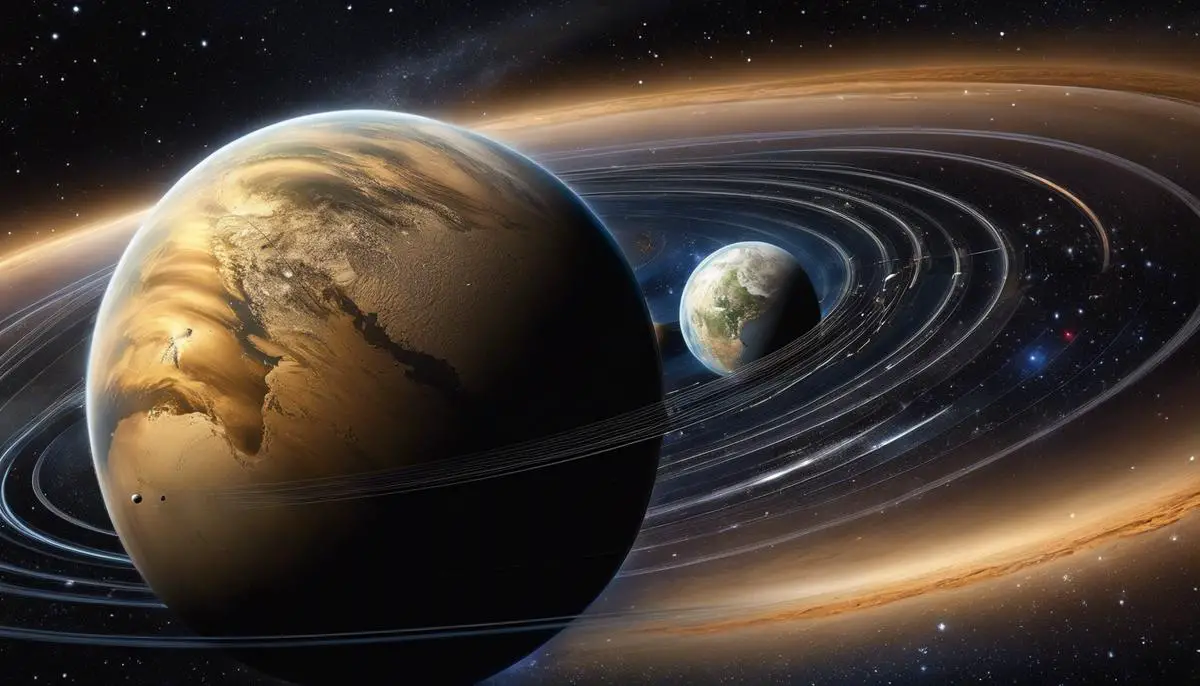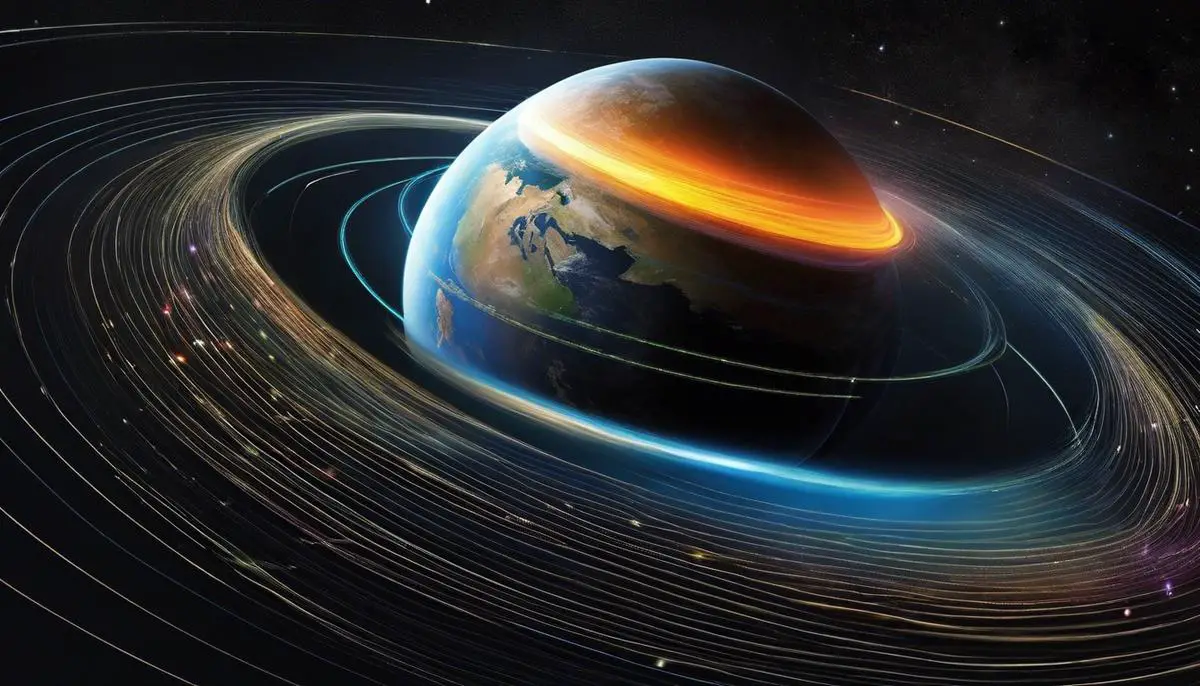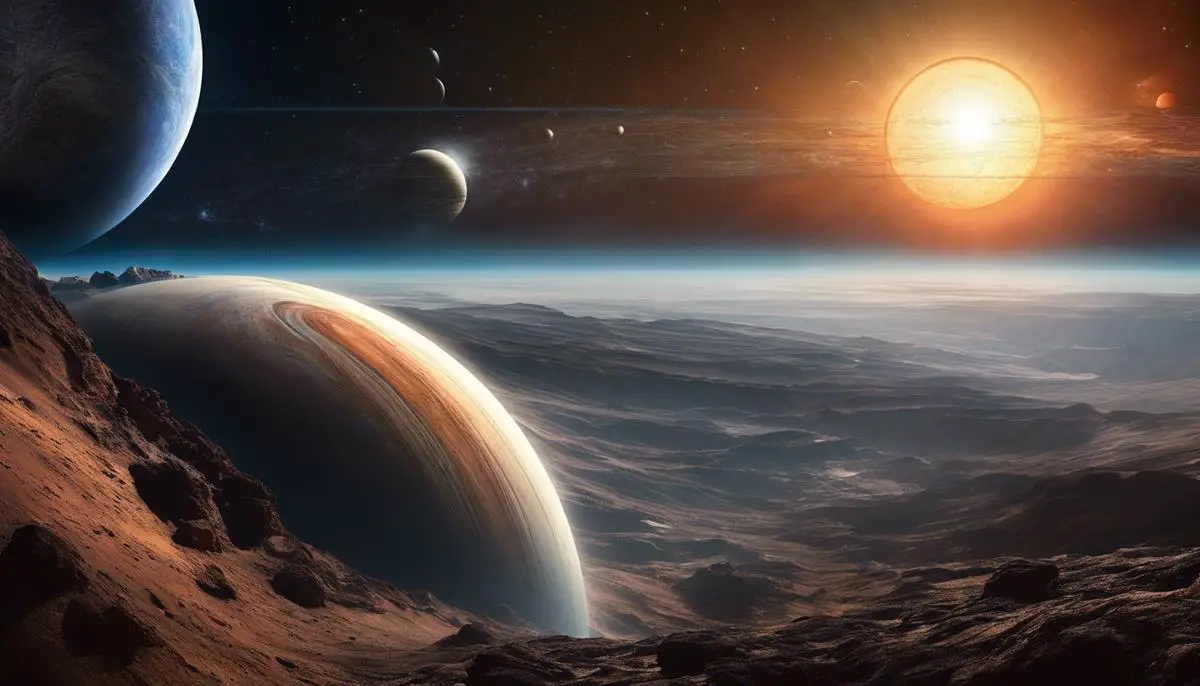Embarking on a cosmic journey through our solar system, we find ourselves captivated by the enchanting array of celestial bodies that revolve around our Sun. From the sun-scorched surfaces of the inner rocky planets to the distant, mysterious realms of gas and ice giants, each planetary entity offers a unique narrative in the cosmic saga. Within this odyssey, the rich tapestry of planetary composition and structure unfolds, revealing the intricate layers and complex geophysical phenomena that define these orbs. As we traverse this celestial landscape, we will venture into the dynamic and ever-evolving atmospheres that cloak these bodies, where the intricacies of climate and weather systems beckon us to understand the forces that shape their environments. Thus, the stage is set for a compelling exploration of the unyielding dance of orbit and rotation dynamics and the magnetic forces that govern the interactions between space weather and the planets they encounter.
Planetary Composition and Structure
Deciphering the Composition of Planetary Interiors in Our Solar System
The elucidation of planetary interiors within our celestial neighborhood extends beyond mere curiosity; it lays the groundwork for understanding the formation, history, and potential habitability of planets. The constitution of a planet’s inner layers is a complex interplay of materials, pressure, temperature, and the long chronicle of planetary differentiation and evolution.
At the most rudimentary level, the internal makeup of the planets in our solar system can be categorized by their primary composition of gases, rocks, or a combination of icy substances interspersed with rock. Terrestrial planets, comprising Mercury, Venus, Earth, and Mars, have dense, rocky interiors with a core, mantle, and crust, where silicate rocks and metals dominate. Jovian, or gas giant, planets such as Jupiter and Saturn, reveal under their thick gaseous exteriors a probable rocky or icy core enveloped in metallic hydrogen and helium. By contrast, the ice giants, Uranus and Neptune, display a mantle enriched with volatile substances often termed ‘ices,’ which include water, ammonia, and methane, surrounding a solid core.
The technique of seismic monitoring offers invaluable insights into the terrestrial planets, wherein the propagation of seismic waves divulges details about the density and state of materials within. On Earth, decades of seismology have illustrated a stratified inner structure with a solid inner core of primarily iron and nickel, a viscous outer core, a highly viscous mantle, and a solid crust. Such seismic data are scant for Mars and virtually nonexistent for Mercury and Venus, although NASA’s InSight mission has begun to pave the way for Martian seismic explorations.
For gas and ice giants, the lack of a solid surface precludes traditional seismic studies, prompting the pursuit of alternative methodologies such as measurements of gravitational fields and magnetic fields in concert with theoretical modeling. The Juno mission to Jupiter and the Cassini probe to Saturn have contributed vastly to our understanding of gas giants by measuring their gravity fields, indicating differential rotation and complex interior structures.
Spectroscopy offers another avenue for probing planetary composition; by analyzing the absorption and emission lines of electromagnetic spectra, scientists can infer the elemental and molecular makeup of the planetary atmospheres, which may hint at the materials contained within. The composition of planetary rings and moons, investigated through remote sensing and direct sampling (in the case of the Moon), further constrains models of planetary interiors.
The internal temperatures of planets, too, have overarching implications for their composition and phase of materials. Jupiter’s and Saturn’s immense pressures create layers of metallic hydrogen, a state unattainable on Earth. Uranus and Neptune with their lower pressures avoid this peculiarity and present a composition less distinct from the ice found in their ring systems and moons.
As for Earth and its Rocky terrestrial counterparts, differentiated layers are a testament to eons of thermal dynamics and planetary recycling processes, such as mantle convection and plate tectonics in Earth’s case.
Lastly, the study of meteorites – remnants of the early solar system formation – provides a comparative baseline for extrapolating the protoplanetary materials that may have contributed to each planet’s nascent bulk composition.
In conclusion, the internal structure of planets is a reflection of primordial construction materials molded over time by pressure, temperature, and dynamics unique to each celestial body. The continual advancement in remote sensing technology, gravitational profiling, and space exploration missions will further demystify these deep planetary secrets, contributing profoundly to our cosmic understanding.

Planetary Atmospheres and Climate
Atmospheric Governance of Planetary Climates: A Comparative Analysis
The atmospheric science of extraterrestrial bodies has advanced significantly in recent years, allowing for a detailed comparative analysis of how different planetary atmospheres govern their respective climate systems. Beyond mere composition, the complex interplay between atmospheric dynamics, solar insolation, and internal heat processes sculpt the multifaceted climates observed across our solar system.
Each planet’s atmosphere acts as a thermal blanket – a critical regulator of surface conditions. On planets with thick atmospheres, such as Venus, the substantial layers of greenhouse gases precipitate extreme surface temperatures, exemplifying a runaway greenhouse effect. It is the dense carbon dioxide atmosphere that maintains Venus’ surface temperature at blistering levels, regardless of its solar proximity being less than that of Mercury.
Conversely, Mars, with its thin atmosphere and lack of a substantial magnetic field, fails to retain sufficient solar heat, illustrating how atmosphere composition and density directly influence thermal retention and, consequently, climate. Mars’ atmospheric thinness permits ultraviolet radiation to reach its surface largely unimpeded, ushering in drastic temperature fluctuations between day and night.
The gas giants, including Jupiter and Saturn, present a different paradigm of climate systems, primarily driven by internal heat rather than solar insolation. The depth of their atmospheres results in high pressure, which in conjunction with internal heat, generates dynamic weather systems featuring colossal storms and high-velocity winds. These climate features are sustained not by solar warmth but by the conversion of gravitational contraction into thermal energy within the planet’s immense atmosphere.
The ice giants, Uranus and Neptune, contribute yet another dimension to the discussion with their climates heavily influenced by the presence of methane and other hydrocarbons. Their striking blue hues, attributed to methane’s absorption of red light, imply particular atmospheric chemistries that, alongside solar isolation, mold their distinct weather patterns such as Uranus’ extreme axial tilt leading to unique seasonal variations.
The Sun, of course, remains an indomitable force in shaping climate as solar energy impinging on a planet’s atmosphere dictates basic thermal characteristics, compounded by orbital eccentricities that can further modulate climate behavior through varying distances from the solar furnace.
It is imperative to recognize the role of magnetospheric interactions in shaping atmospheric characteristics and thus, a planet’s climate. A strong magnetic field as seen in Earth offers protection from solar winds, preserving a relatively stable atmospheric system conducive to a temperate climate. The lack of such a field on Venus and Mars underscores the susceptibility of a planet’s atmosphere to solar activity, with substantial implications for atmospheric retention, composition, and surface conditions.
In summation, the climates of different planets are governed by a complex matrix of atmospheric composition, density, solar energy, internal heat, and magnetospheric interplay. The continuation of data acquisition via robotic exploration, remote sensing, and theoretical computation will progressively elucidate these entangled factors, enhancing our fundamental comprehension of planetary science, and invariably refining our knowledge of Earth’s climate within the universal context.

Orbit and Rotation Dynamics
Orbital Mechanics, Rotation, and Planetary Characteristics
Orbital mechanics and rotation exert profound influences on the characteristics of planetary bodies within the solar system. Their interplay governs not only the observable dynamical properties but also underpins various physical processes that shape planetary environments.
Orbital Dynamics and Seasonal Variability
Planetary orbits, elliptical in nature due to the gravitational forces described by Kepler’s laws, determine the amount of solar radiation a planet receives throughout its year. For planets such as Earth, the axial tilt in conjunction with its orbital eccentricity leads to the waxing and waning of seasons. Conversely, a planet with minimal axial tilt and a circular orbit, such as Jupiter, experiences relatively uniform distribution of sunlight, reducing seasonal variations. Seasonal changes are pivotal in driving climatic patterns and affect geological and biological processes.
The Role of Rotational Period
The rotation of a planet around its axis, which defines the length of a day, is integral to the distribution of thermal energy across its surface. A rapid rotation, such as that of Jupiter, can trigger substantial atmospheric dynamics leading to the formation of prominent banded structures and large-scale storm systems. Slow rotators like Venus subject their day-side to prolonged solar exposure, generating extreme surface temperatures and influencing the chemistry of the atmosphere.
Gravitational Locking and Tidal Forces
Tidal forces arise from the gravitational interaction between a planet and its satellite or, in a broader context, with other planetary bodies. The Moon’s gravitational pull on Earth, for instance, is instrumental in the modulation of ocean tides, which play a role in heat distribution. Gravitational locking, or tidal locking, whereby a satellite shows the same face to its primary (as the Moon does to Earth), accentuates one-sided climatic and geological characteristics. On the locked body, stark contrast emerges between the perpetual day and night sides, affecting atmospheric circulation and surface temperature regimes.
Angular Momentum and Planetary Shaping
A planet’s angular momentum, conserved from the protoplanetary disk, dictates its rotational velocity, which, in turn, can cause an oblate shape as seen with Saturn. Faster rotation tends to flatten a planet at its poles and bulge at the equator, impacting the distribution of mass and consequently, the gravitational field. Such deviations can result in differential heating effects and influence atmospheric dynamics.
Centrifugal Balance and Atmospheric Escape
With rotation comes centrifugal force, countering the planet’s own gravity. In atmospheres where thermal speeds of lighter gases approach escape velocity, rotation might assist in atmospheric loss, dramatically altering a planet’s composition and physical appearance over geological timescales. The young, hot planets and moons with their rapid spins may have lost primordial atmospheres partly due to this process, influencing their evolutionary trajectories.
Conclusion
The integration of astrophysical principles such as orbital mechanics and rotational dynamics is vital in comprehending the complex nature of planetary characteristics. Extensive and persistent research efforts tease apart the nuances of these celestial relationships. To enhance our grasp of planetary science, continuous observation and analysis through forthcoming missions and advanced instrumentation will serve to unravel the complexities of our cosmic neighborhood.

Planetary Magnetism and Space Weather
The magnetosphere: its pivotal role in shaping the space environment around planets
Magnetic fields, an invisible yet forceful presence, emanate from the interiors of many celestial bodies, providing a shield known as the magnetosphere. This protective region is critical in defining not only the characteristics of the near-space environment but also in safeguarding planetary atmospheres from solar wind erosion—a continuous stream of charged particles emanating from the Sun.
Understanding the magnetosphere begins with recognizing its origin—the dynamo process, driven by the interaction of thermal and electrical conductivities within a planet’s fluid core. In terrestrial planets, such as Earth, this process results in complex geomagnetic fields that extend far into space. In gas giants, the magnetic fields are even more extensive, generated by the motion of conductive materials in their vast interiors. For instance, Jupiter’s magnetosphere is the largest planetary structure in the solar system, so massive that it envelopes some of its moons, shaping their space weather conditions.
Magnetospheric studies are paramount, revealing the complex relations between a planet’s intrinsic magnetic field and the external influence of the solar wind. These interactions form features such as bow shocks—a buffer zone where the solar wind decelerates abruptly upon encountering a planetary magnetic field—and magnetotails, lengthy structures trailing planets on the side opposite to the Sun. For Earth, the magnetic field serves as a defense mechanism against solar radiation, fostering habitability. For planets without significant magnetic fields, like Mars, the lack of this protection has dramatic consequences for atmospheric retention and habitability.
Magnetic reconnection, a fascinating phenomenon occurring within magnetospheres, is yet another focal area of study. It occurs when solar wind magnetic field lines ‘connect’ with those of a planet’s field, allowing energy transfer that drives space weather events such as the aurorae observed on both Earth and other magnetized planets. By studying these interactions, scientists uncover invaluable information that aids not only space weather prediction but also contributes to our understanding of cosmic plasma processes, leading to broader astronomical and physical insights.
Exoplanets—planets outside our solar system—offer a newfound domain where magnetosphere analysis can further be applied. The detection of exoplanetary magnetic fields is on the horizon of astronomical techniques and promises to illuminate the diversity of space environments throughout the cosmos. By examining magnetic fields, astronomers can infer core properties, atmospheric shielding capabilities, and perhaps the potential for extraterrestrial habitability.
Moreover, anthropogenic technologies in near-Earth space rely on accurate models of magnetospheric dynamics to prevent damage to satellites and instruments—a real-world application of this esoteric expertise, encompassing telecommunications, weather forecasting, and global positioning systems.
In conclusion, the magnetosphere represents an indispensable natural feature that plays a multifaceted role in shaping planetary environments. It interacts with solar and cosmic phenomena to impact atmospheric longevity, climate, and the potential for life. As humanity endeavors further into the cosmos, understanding these magnetic fields will continue to be paramount in navigating and appreciating the intricate dances of planets within the vast celestial ballet.

Our exploration through the solar system illuminates the profound intricacies and wonders that comprise the planets orbiting our Sun. Each step of our celestial trek has unveiled the underpinnings of planetary science, from the dense metallic cores to the lofty atmospheric heights, from the subtle waltz of gravitational interactions to the protective embrace of magnetospheres. As we return from our cosmic sojourn, we carry with us a deeper appreciation for the delicate balance of forces and phenomena that create the symphony of our neighborhood in space, an ongoing testament to the majesty of the universe and the relentless curiosity that propels humanity to unravel its mysteries.
![]()
